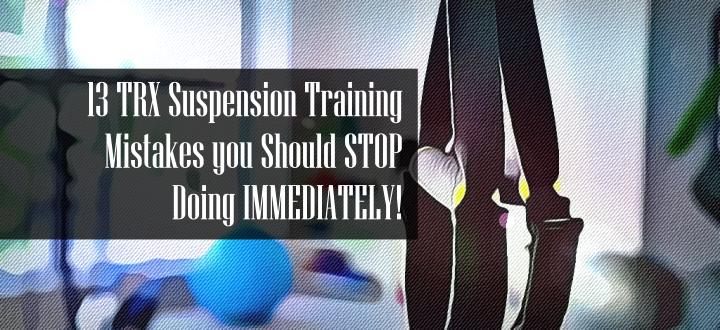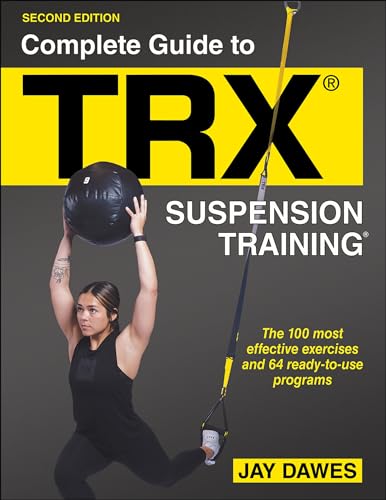Suspension training.
Two straps and your body weight. How hard can it be?
Actually, it’s harder than you imagine. At least if you aim to get the most out of your exercise – and at the same time, avoid injuries.
Check out these suspension training common beginner mistakes, and make sure you do not get caught in the rookie trap yourself!
Contents
Suspension Trainer Common Beginner Mistakes: What NOT to do
You Are Starting The Exercise Positioned Wrong
I assume you already own one of these best suspension trainers. If not, get one!
Owning a pair of quality suspension trainer straps is essential if you want to be serious about your suspension training.
In addition to owning quality equipment, you will have to be sure to do all the movements correctly:
If you’re not in the right position when starting the movement, you will most likely end up struggling.
You will either have your suspension trainer lose its tension in the straps, or you will find yourself doing movements not targeting the intended muscles – which might even hurt you.
Both your feet and your body should be positioned correctly to maintain a safe and effective exercise. The position of your feet and your body decides how hard/ heavy the exercise will be to perform.
You do not want to stop in the middle of your set to adjust either the position of your body or your feet.
Make sure you know how to do the exercise before starting. If you are unsure, Google it or do a Youtube search.
If you want results, you must do movements that build your muscles, not hurt them.
Your Core Is Not Engaged
When we are getting all drained of energy, keeping that core tight is damn hard.
And the bad news is you risk getting yourself injured when your core begins to sag!
So remember:
Keep that back of yours safe by making sure your core is engaged at all times during the exercise!
Be a surfboard against a wall; keep your body rigid with no bend.
When engaging your core for stability, the goal is to create as solid a ring of muscles around your mid-section as possible. To achieve that, you have to activate your core muscles slightly outward, stiffening them to create a protective “cylinder” around your abdomen.
Resource: yourfunctionalhealth.com – How to Engage Your Core Effectively
The Suspension Trainer Straps Is Not Tight
Come on! Keep those straps nice and tight!
Loose straps will both reduce the intensity and make your exercise ineffective.
Also, the floppy straps can increase the risk of injury, causing sagging in the mid-section of your body.
As a matter of fact, you are doing the exercise all wrong if the straps are not tight through the whole movement.
You should never, at no cost, let the straps be loose!
OK?!?
You Are Scraping The Straps Towards Your Arms
Ouch!
Red marks on your arms and shoulders after suspended push-ups. Not Good!
Why are your arms all soar?
You have been rubbing the suspension straps towards your arms like you were trying to wax your car.
Resting the straps on the skin makes the exercise easier, but it also makes the exercise way less effective.
Make sure to position your body in a way that you can perform the exercise like it is supposed to be done. If you cannot do it without scraping the bands against your arms, you will need to adjust your position.
In addition to driving your body through the push movement, focus on using the stabilization muscles in your arms, keeping the trainer straps away from your skin.
Once more, AWAY from your skin!
RELATED:
You Are Giving Up
Some days you’re just exhausted after work. Your energy levels are at a low, and the exercises you usually do feel like moving mountains.
Argh, I hate those days!
But don’t let this ruin your workout. Instead of throwing in the towel, adjust your body position to find a resistance you are comfortable working with.
Remember, the position of your feet and your body decides how hard/ heavy the exercise will be to perform.
It is better working out with less resistance than giving up or “cheating” (which may result in injuries).
Your Joints Are All Over The Place
Elbows all over the place, incorrect pelvis tilts, and knees in unfavorable positions. When exercises get too hard, the road to cheating is not long.
But cheating could get you in a lot of trouble, so stop it right now!
Stop Using Momentum, Stay In Control
You should be in control of the exercise from start to end of the movement. Using momentum to swing your body through the movement leaves you with a useless exercise.
This is a rule of thumb concerning all types of training. Either you are using dumbbells, rubber bands, or a suspension trainer.
Going through the gym, you most certainly will see at least one individual THROWING those dumbbells up while doing biceps curls.
Looks pretty comical, right?
By staying in control, you assure you are getting the most of each repetition while keeping your body safe from injuries.
Check out how Dan Long stays in control while showing you three suspension training core exercises for beginners:
RELATED:
You Are Not Focused
Using the suspension trainer, whether beginner or advanced, you have to stay focused throughout the whole movement of each exercise.
You want to keep “mental contact” with your muscles at all times, making sure you are engaging the muscles you are supposed to.
Using fixed exercise equipment like machines at the gym, you do not need to pay attention to the muscles other than following the pre-fabricated movement.
With the suspension trainer, you are moving your whole body, making sure you are working the muscles you are supposed to take concentration and mind control.
You Are Not Keeping Your Limbs In Position
Using gravity is both benefiting the suspension trainer and putting it to a challenge.
When unequal pressure is applied in the foot cradles or handles, you could experience your hands or feet swinging up and down rather than staying in their position.
If you are experiencing this:
STOP!
Adjust the suspension trainer so that the straps are parallel.
When doing the movement, concentrate on applying equal pressure to each strap and staying in control.
Remember to keep your core tight!
If you still cannot keep those hands and feet still, consider applying less resistance by adjusting your body position.
You Are Playing Pro When Still a Newbie
Master the basics before doing the super-advanced-technical-ninja-style exercises the professionals do on Youtube.
You need to have a basic level of fitness and coordination to get the most out of even the simplest TRX workouts and to be safe.
You should have a trainer working with you to be sure your technique is on target to help avoid injuries.
Reference: webmd.com – TRX Suspension Workout: What to Expect
By jumping into exercises you do not have sufficient strength or technique to do correctly, you sure as damn won’t gain any muscle. – If anything, you’ll earn a damaged back.
And you do not want that…
The 3 Most Common Suspension Training Mistakes: From a Personal Trainers View
Being a self-thought hometraininghero myself, I had to ask a REAL expert for her professional opinion.
Sophie Manfredi, Co-Founder, and owner of the True Conditioning training community, is an award-winning certified Personal Trainer, Nutrition Coach & TRX Qualified Group Fitness Instructor.
Sophie has coached 100’s students using the suspension trainer and has seen a lot of TRX mistakes over the years.
So, I asked her the question:
What do you think is the most common mistake people new to suspension training should be aware of?
And she hit me back with the following answer:
“As for the most common mistakes, here are my top 3:
1. Starting too far in. I would say beginners tend to start too far in towards the anchor point, throwing off their body position. I encourage new clients to start at the end range of the motion, and if they find it’s too easy, they can always move in to make it harder.
2. Gripping too hard on the trainer and tensing their shoulders. I focus on cueing staying relaxed through the shoulders and neck, and keeping a light grip on the trainer.
3. Relying too much on the trainer. I find people overuse the trainer in exercises like the single-leg squat or single leg lunge, which then takes the focus away from the lower body. Instead of leaning too far back like they are water-skiing on the trainer, we cue to maintain a light grip and to keep their weight over the top of their heels.”
Looking at Sophie’s top 3 common mistakes, I can honestly say that I have been guilty at all of these during my first time with the suspension trainer.
I started using the TRX about ten years ago as I did not have sufficient time in my life to fit in a gym visit during the day.
Hooking the suspension trainer up to my door frame gym bar, I both started the movements with my body in wrong positions – and squeezing the handles like there was no tomorrow.
And when doing squats, I nearly hang in the straps instead of using them as balance support.
We have all been beginners at some time, and even the coolest boys and girls in town can make mistakes.
Final Words: No More TRX Mistakes
Yeah, the suspension trainer is a non-complicated piece of training equipment.
And sure as damn, everybody can use it.
But as with all training equipment, you have to do the movement and exercises correctly to see results.
As a beginner, your priority before applying massive resistance should be to master the basics.
- Get to know the system.
- Work on your technique.
- Learn the basic exercises.
- Or do it the easy way; – take some TRX classes.
And to sum it off:
- Your body/ feet position and body angle decide the resistance of the exercise.
- Remember to have your core engaged during every exercise. Neglecting a tight core may result in back injuries and no more exercise in a while.
- Make sure to stay in control at all times during the movements of the exercise.
I trust these mistakes will never be present during your upcoming rounds of living room workouts.
Oh, and one more thing:
Please visit and bookmark my strength training archive – LOADED with tips, hacks, and exercise routines!
Other Helpful Resources
- Ask the Trainer: Six TRX Training Sins
- Suspension Training vs Kettlebell: Which is the Better?
- What is Unique About Suspension Training, And Is TRX Good for Beginners?
- Best Dual Anchor Suspension Trainer Reviews
- What is the Best DIY Suspension Trainer System? Reviews of the Scooby-style SRX Suspension Trainer
- TRX Suspension Training Workouts & Exercises: The Ultimate Guide
- How Do You Reduce Risk of Injury? Ask the Trainer








